#obligatory: i love drawing water and I LOVED working on that background
Text

Comet's Log: Chao Garden
"I found what I think are like those dirt gardens that I’ve seen some Surfacers have back home. This one seems fancier though. There’s a rock formation with water just pouring out by itself, no pipes or anything; as well as some pretty plants. But, what’s really interesting are these tiny creatures that are living here. They have big heads and weird eyes that are kinda ugly (in a cute way)! They seem friendly enough too. Like, a few of them had sharp teeth, but nobody bit me or anything. Didn’t even really pay me any mind at all.
My stomach rumbled real loud (I forgot I hadn’t eaten since before I got here!) all of a sudden. Then one of the little guys, a blue and yellow one, walked over with this weird fruit(?) in its teeny-tiny arms. It was trying to give it to me! How sweet! Unfortunately, I didn’t want to eat it because it might be poisonous.
I tried to communicate that I didn’t want it, but the little guy insisted. A few more of them noticed and came over to see what was going on. I panicked, so…I just flew away and didn’t look back. I still feel kind of bad about it."
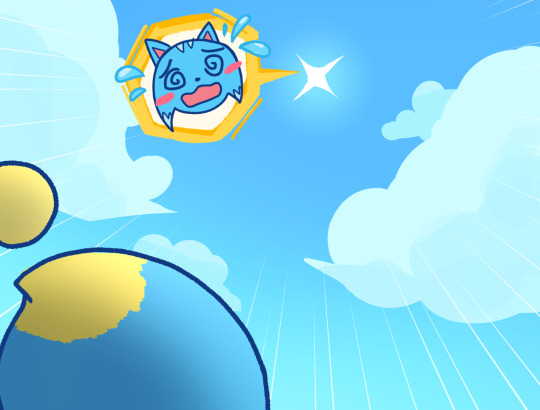
Extras below the cut:
I've decided to make the raw .clip layers available for download [HERE] for educational purposes. if y'all want it <3
Also! the purple chao is @genotaurus' Cloudy ✨
Some Edea lore notes:
Chao don't exist on Edea
Since she grew up in a space colony, Comet is only familiar with hydroponic farms/gardens. Dirt farms only exist on Edea's surface.
Also because of growing up on Ark Elysium, Comet barely has any experience interacting with "wild animals" or even pets in general.
#sonic oc#sonic fc#chao#my art#my ocs#comet's story#me? telling this story EXTREMELY out of order?#yes. yes I am ✨✨#this excerpt is part 4 out of (currently) 7#one day I'll compile it all properly#but a story told out of order is better than a story not told at all <3 peace and love#obligatory: i love drawing water and I LOVED working on that background#oc: comet the hedgehog
141 notes
·
View notes
Text
Sora/Kairi in KH3 - Conversation with Chirithy Scene
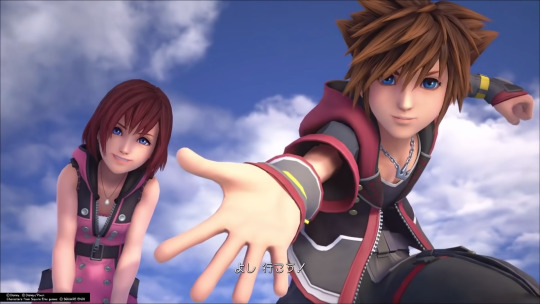
This is the fourth in a series of translation posts I’ve done about Sora and Kairi’s scenes in KH3. The first post about the paopu fruit sharing scene can be found here, the second post about the light in the darkness scene can be found here, and the third post about Sora’s speech before he saves Kairi can be found here.
Here’s a general key for the kind of analysis I like to do:
JP: Official Japanese Dialogue
EN: Official English Dialogue
TR: My Translation (usually more literal and thus more stilted than the official English version. I’m not using natural-sounding English in order to stick as close to the Japanese versions of the lines as possible for the purpose of analysis)
Notes: things I found interesting, grammatical points, extra thoughts, etc.
One last note: media doesn’t exist in a vacuum. Every work of art is influenced by other art and by the cultural background of the people who made it. Kingdom Hearts, for all its ties to Disney, is still very much a Japanese game, so it should be analyzed in light of that.
With that in mind, let’s continue.
Sora and Kairi arrive at the Final World, which earlier Sora described as the world of ocean and sky. One possible reading of the kai part of Kairi’s name, as many of you know, can mean ocean/sea, 海, and Sora’s name can be read as sky, 空. They’re visiting a world that has a lot of symbolic significance for their names, and they’re here together, which perhaps Sora’s words hinted at all along.
Notice how Sora carefully holds onto Kairi as they land, and she likewise has her hand resting on his side. At first they seem surprised/unsure...

...and then their expressions change to joy as they admire the view around them:
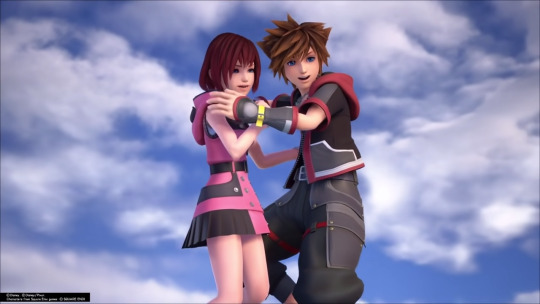
They look at each other as if to share this moment together. Sora offers Kairi his hand, and she takes it as they float to the ground:
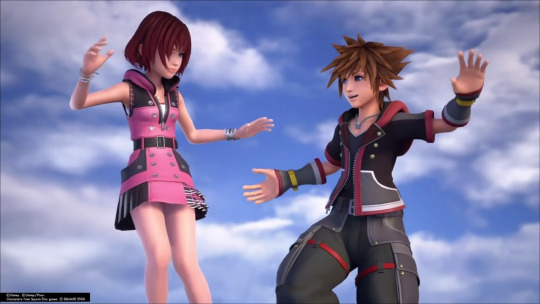

Then they land, though there is no ground here, just water. It is the world of ocean and sky, after all. The camera focuses on their feet to draw attention to the fact that this isn’t a normal world; only water and sky exist as far as the eye can see. Notice how Kairi positions her feet with her toes pointed slightly inward. This is considered cute and ladylike in Japan, and Kairi poses like this to give hints about her character to the audience. Notice how Sora’s toes point outwards to indicate a more masculine stance:
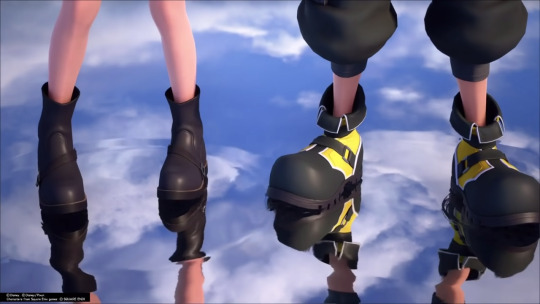
The medium close-up shot here frames Kairi’s reaction to the Final World, allowing the audience to empathize with her and take in her reaction to her surroundings:
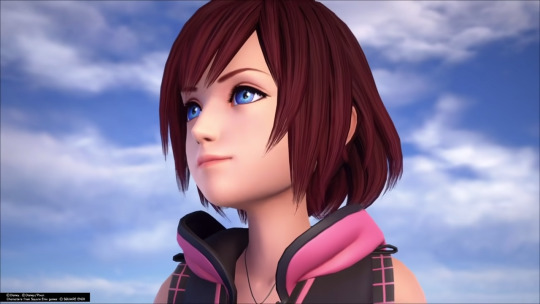

Note the look of joy and wonder on her face:
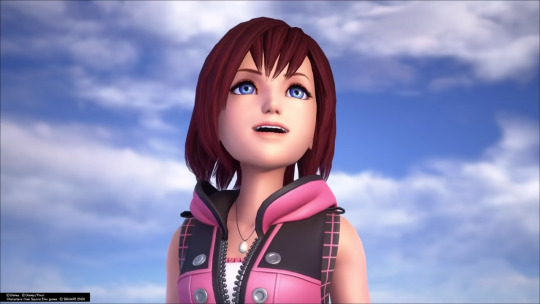
Next, we get this long shot/wide shot of the two of them, still holding hands, to emphasize the vastness of the Final World and how amazed they are by the sheer size of the place:

The camera even zooms out to emphasize how small they are compared to how big the Final World is:

We go back to a medium shot of Kairi as she continues to admire the view. Again, this experience is framed in terms of her wonder and joy:

And then Sora enters the frame...

...but the focus is still on Kairi...
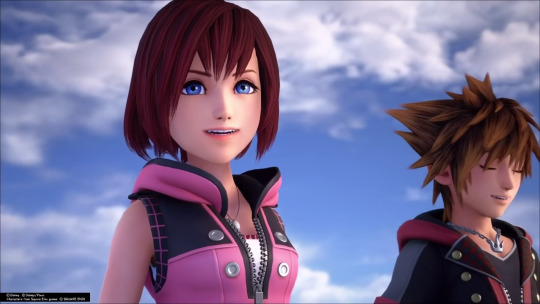
...as he gazes at her in a way that can best be described as adoring:

JP きれいー
EN It’s so pretty...
TR It’s so prettyー
Notes: The Japanese version has Kairi drop the copula da after “pretty,” probably so that she will sound more feminine. The English version picks up on this and has Kairi say “so,” which is more common in feminine speech than in masculine speech.
Sora continues to admire Kairi, even though he’s in such a beautiful place. Kairi is what draws his attention despite the stunning view around them. She’s more beautiful to him than anything else, and everything else fades away in importance for him:

His eyebrows even relax a little and his eyes do this affectionate squint almost, just to show how comfortable he feels around her and to indicate his feelings for her:

The camera focuses more on him in this shot, a clue that we’re supposed to pay attention to what he’ll do next:

We see the same eyebrow relaxing and eye squinting that happened earlier:

And then something else catches his attention, and his expression sobers considerably. There is sadness in his eyes, even at a happy time like this:

The camera cuts to his hand, which, as we can see, is starting to fade out of existence. The shot is from his POV here, indicating we’re experiencing what’s happening through his eyes:
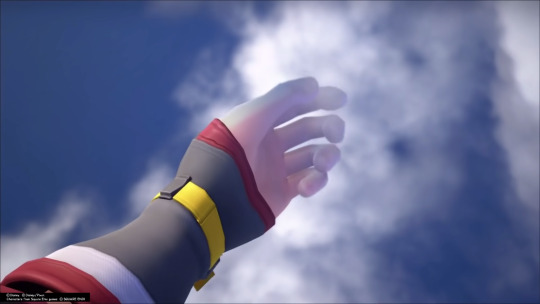
He spreads his palm out as his entire hand goes translucent:
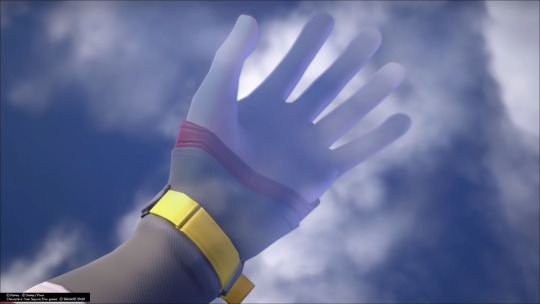
But only temporarily, as it becomes solid again as he watches:
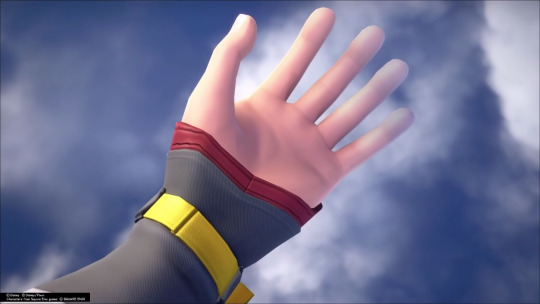
Next we get this low angle shot of Sora reacting to the change, probably to include both his hand and his face in the shot. Still, it’s interesting that this choice of shot was used, because usually it’s used to emphasize power dynamics. Perhaps it is done here to make Sora seem larger-than-life? His breath catches here as well in both the English and the Japanese versions:

Sora curls his fingers here...

...and makes a fist. Note the look of resignation/determination on his face:

Then he turns to Kairi:
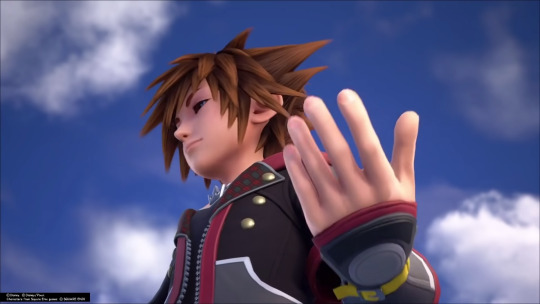
He doesn’t dwell on what’s happening and doesn’t feel sorry for himself. No, his concern is with Kairi and with getting her home:

JP カイリ
EN Kairi.
TR Kairi
Notes: Nothing really to note here, Sora just says her name to get her attention. He says her name frequently in Re:Mind, almost as if he’s waiting for every possible excuse to say it.
This next frame shows the two of them about equally, to indicate the focus is on both of them now:

JP 帰ろう みんなが待ってる
EN Come on. Everyone’s waiting.
TR Let’s go home. Everyone’s waiting.
Notes: The intonation for both the English and Japanese versions are pretty similar here. Sora’s voice falls on both sentences to indicate he isn’t asking a question, he’s suggesting what they do next. He uses casual forms of the verbs because he and Kairi are comfortable with each other and know each other well. The verb for “go home,” kaeru, is often used to indicate returning to one’s home, so it’s clear he wants to take her back to Destiny Islands like he promised he would.
Next, we get a shot focusing on Kairi’s face and reaction:

JP うん
EN (Kairi just makes an affirmative noise in the English version)
TR Okay
Notes: Kairi agrees to Sora’s suggestion and nods.
Her eyes also do the same affectionate squint that Sora’s did earlier when he looked at her. They’re mirroring each other’s body language:
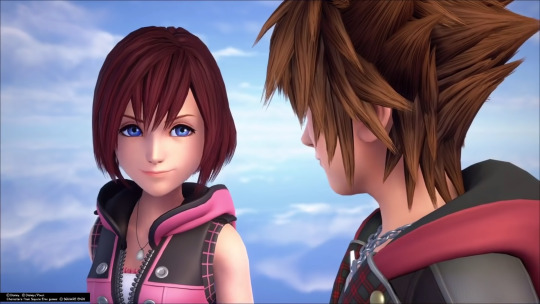

Then we get this shot to show Sora’s reaction to her, and look at the love in his eyes:
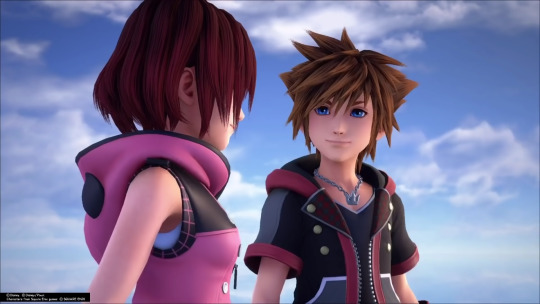
Then he smiles this precious smile that also strikes me as deeply sad, in a way. I don’t know if that was intentional, but considering how his fate must be weighing on his mind and how hard he’s trying to make sure Kairi’s having a good time, it might very well be on purpose. It’s also a very brief smile in comparison to some of his other smiles and strikes me as a little forced for that reason:
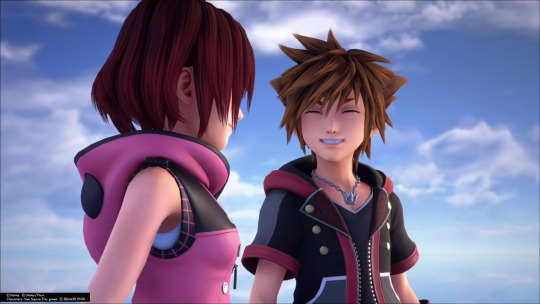
Notice again how his smile isn’t really reaching his eyes. They’re open too wide in comparison to his earlier, genuine smiles:

Though his expression here does seem happier/more content, now that he’s smiling more naturally:

Then he remembers Chirithy:

JP あっ!
EN (Sora just makes a surprised noise in the English version, like he’s suddenly remembering something)
TR Oh!
Notes: Pretty similar in both versions; Sora’s expressing that he just remembered Chirithy.
He looks around...

...and the camera cuts to a shot of Kairi watching him look around:

She even leans forward a little to try to meet his gaze...

...and asks him a question:
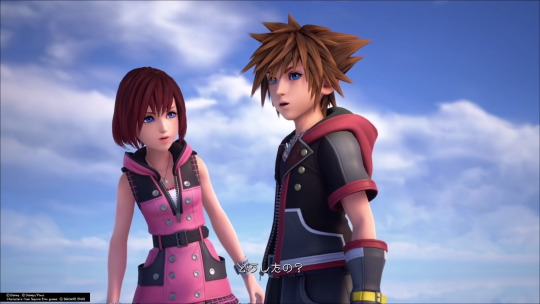
JP どうしたの?
EN What’s wrong?
TR What’s wrong?
Notes: Sora murmurs ええと to himself right before Kairi asks him what’s wrong, and he says “uh” in the English version. Pretty similar in meaning to one another, and it shows the localization team’s attention to detail.
Kairi uses the particle no at the end of her statement in Japanese along with rising intonation to indicate she’s asking a question. In the English version, she just uses rising intonation and the fronting of the wh-word “what” to do so. She asks the same thing in both languages, just uses slightly different linguistic tools to do so.
We get this full shot of the two of them to show that Chirithy is nowhere to be found:

JP うん 友達がいるはずなんだけどー
EN Well... My friend should be here, but...
TR Well, (my) friend is supposed to be here, butー
Notes: The Japanese and English versions are pretty similar here. Sora uses hazu to indicate that he expected Chirithy to be here, that Chirithy was supposed to be here, but for whatever reason, his friend isn’t showing up. Note though how “my” is assumed from context in the Japanese version and explicitly spelled out in the English version. Japanese can drop pronouns in a lot of instances where they are obligatory in English.
Sora looks around with a hand to his forehead:

In multiple directions:
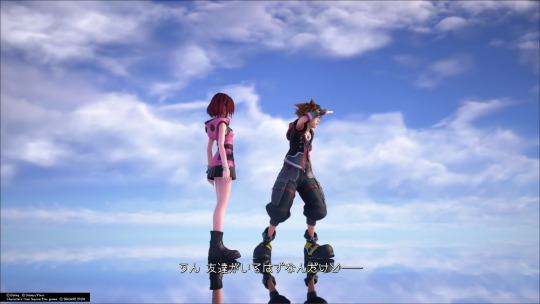
And then calls out to Chirithy as Kairi calmly watches, heightening the humor of the scene:

JP おーい チリシィー!
EN Heeey! Chirithy!
TR Heeey! Chirithyー!
Notes: Again, the English and Japanese versions are pretty much the same. Sora drags out the vowel in both languages as he calls out to Chirithy.
Then we get this odd shot of part of Sora’s leg. Our brains work slightly ahead of the scene...
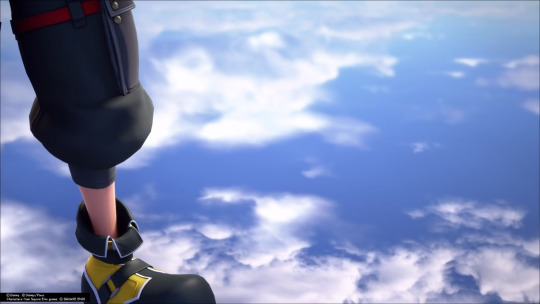
...and poof, Chirithy shows up right by Sora, again heightening the humor of the scene because we expected this to happen a split second before it did. Chirithy’s incredibly unimpressed expression likewise adds to the humor:
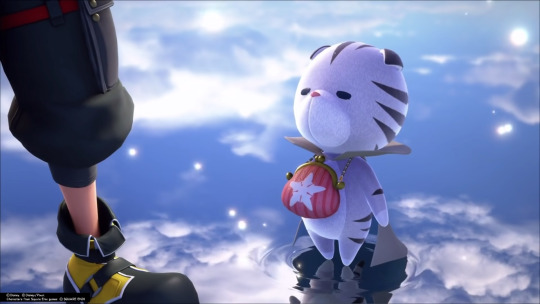
The scene cuts to a long shot of the three of them, Kairi and Chirithy calm while Sora is shocked, which once again adds to the humor of the scene:
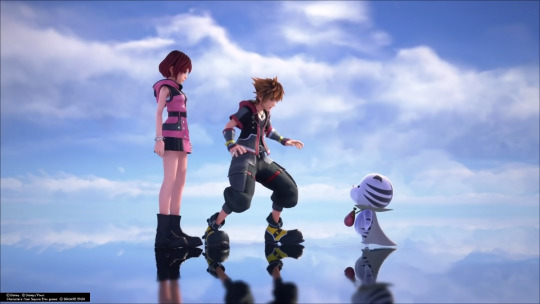
Note Sora’s defensive stance here, because his body quickly reacted to his surprise:

JP 何だよ そばにいたのか
EN Whoa! Hey, why didn’t you say something?
TR What the heck? (You) were here (this whole time)?
Notes: In the English version, Sora sounds more surprised in the first sentence, but in the Japanese version, he just sounds irritated, haha. Granted, he also shows some irritation in the second sentence in the English version, so the overall gist is the same. In the Japanese version, he also uses ~dayo after nan to emphasize his irritation, and ~noka at the end of the second sentence to ask a question and make it clear he wants an explanation from Chirithy.
Notice how in this shot his hands change position to emphasize his desire for an explanation:
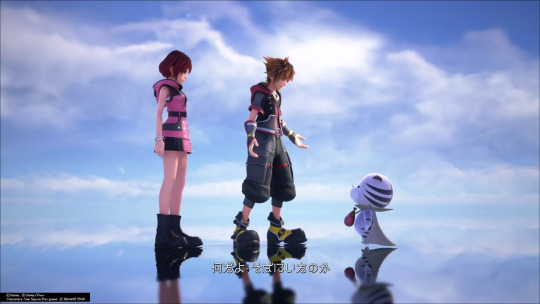
Next we get a shot of Chirithy at a bit of a high angle, probably to emphasize Chirithy’s cuteness and vulnerability:
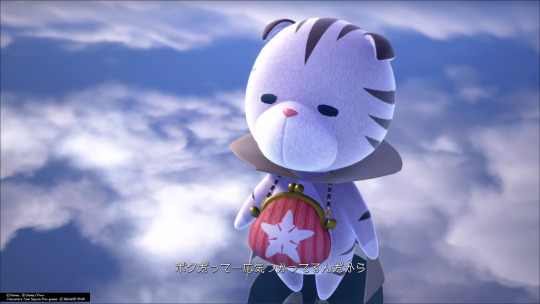
JP ボクだって一応気つかってるんだから
EN I was just trying to give you some privacy.
TR I was just trying to be considerate (lit. Because even I’m [a little] aware/Because even I can be [a little] considerate/thoughtful).
Notes: Chirithy uses an interesting variation of the pronoun boku here. Normally, boku is written in kanji, but here it’s written in katakana, and I’m not entirely sure why. Maybe to make Chirithy sound different or unique?
Anyway, since Sora wanted answers, Chirithy uses the ~ndakara pattern to provide an explanation. Chirithy’s answer is also snarky as all get out in both languages, and it’s really emphasized by the tone of voice and grammar Chirithy uses. I had a little trouble translating Chirithy’s words here and maintaining a balance between a more literal reading and a more “basic gist” meaning. Part of it is because I still have trouble parsing certain formulaic expressions, which is what I’m gathering this one is. But the basic idea is that Chirithy is saying “Yeah okay, even I know when to give you some space, I can be considerate and thoughtful when I need to be, you know.”
Sora and Kairi look at each other and chuckle, but note how they are not denying what Chirithy said. They’re not all that embarrassed, either. This is a huge change from Sora turning bright red and denying Donald and Goofy when they teased him about his crush on Kairi in KH2. Now, he’s comfortable with the idea of the two of them being seen as a couple, with other people giving them privacy, because that’s the sort of thing couples want:
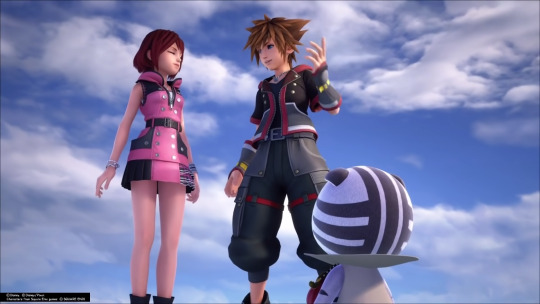
If anything, the way Sora scratches his head screams “Haha oops, guilty as charged, I was definitely enjoying being alone with you, Kairi”:
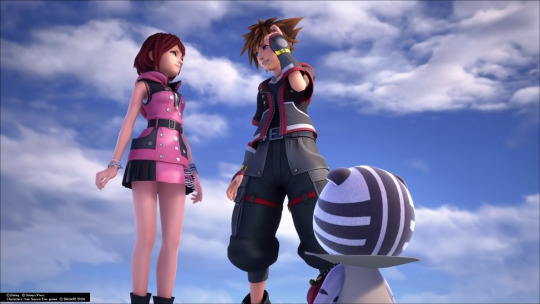
Kairi, as polite and friendly as always, moves to introduce herself to Chirithy. Note how the angle is low to highlight the size difference between Sora and Kairi vs. Chirithy:

But Kairi bends down so she’s closer to Chirithy’s level and offers her hand. This is really similar to what Sora does to show empathy to his smaller friends, and it’s adorable that Kairi does it too. They share a lot in common, and it really shows, even in the little things. It also shows how kind and caring Kairi is, because she’s treating Chirithy like an equal. True Disney Princess right here, befriending all the critters she runs across:
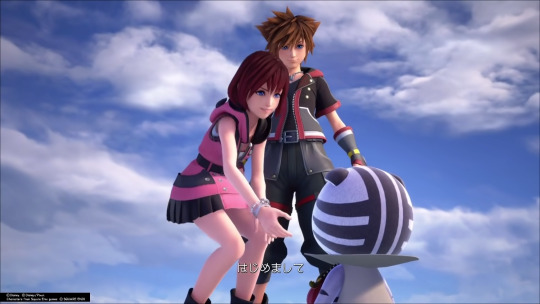
JP はじめまして
EN Nice to meet you.
TR Nice to meet you
Notes: Kairi initiates the set expression used to start an introduction in Japanese, hajimemashite. This phrase also often gets translated as “How do you do?”, but interestingly enough, it’s a conjugation of the verb for “to begin.” It’s just one of those set phrases that has a different everyday meaning than its literal meaning.
The camera shot changes, and we see a full shot with Kairi reaching out to Chirithy as Chirithy tentatively offers its paw:
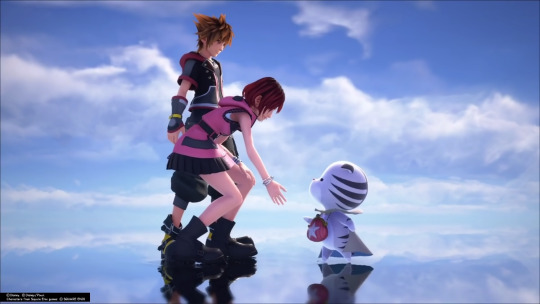
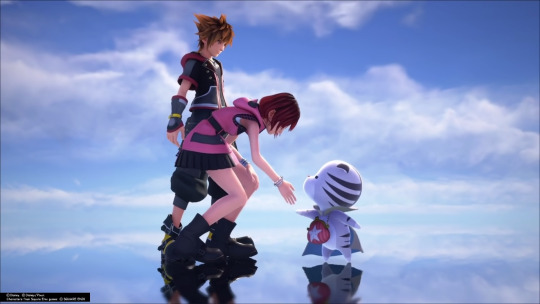
They shake hands, and Chirithy returns the greeting:
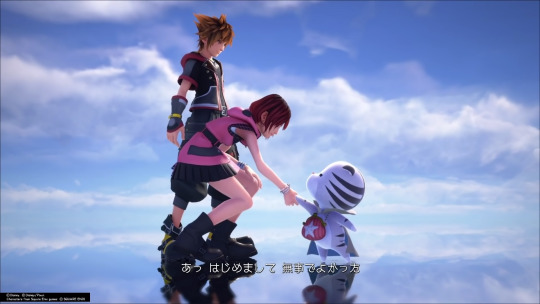
JP あっ はじめまして 無事でよかった
EN Oh, likewise! I’m glad you’re okay.
TR Oh, nice to meet you too! I’m glad you’re safe.
Notes: Chirithy lets out a little expression of surprise, then returns Kairi’s hajimemashite. Chirithy also expresses relief that Kairi is okay using bujideyokatta. Buji can mean several things, which is why I translated it as “safe” and why the official English version went with “okay.”
The next shot is of Sora and Kairi, emphasizing how Sora is about to speak:

Sora bends down a little in the same empathetic gesture he’s used before and Kairi used in this scene to help Chirithy feel more at ease:

JP でさ 俺たち帰るんだけど チリシィもいっしょに来なよ
EN Chirithy, we’re heading home. You should come with us.
TR So, we’re heading home, but you (lit. Chirithy) should come with us.
Notes: Main thing to note here is that Japanese tends to use names when English would use pronouns. Sora uses ore to refer to himself, so it’s no surprise he uses the plural form oretachi to refer to both him and Kairi. His suggestion is worded a bit more strongly than a regular request with the use of the particle yo.
Chirithy is shocked by the proposition, and we get a shot to its reaction that’s almost at eye level to put the focus on Chirithy’s feelings:
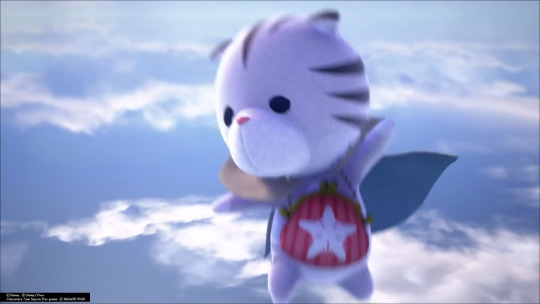
Chirithy staggers back slightly and expresses its incredulity:

JP えええー!
EN Whaaat...?
TR Huuuh?!
Notes: Much like with Sora’s “heeey,” the vowels here are also elongated for emphasis in both Japanese and English.
We get a shot of Sora talking to Chirithy here that includes Kairi as well:
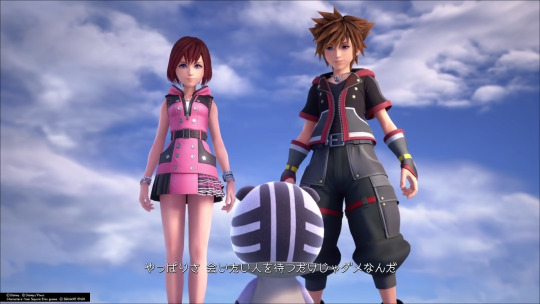
JP やっぱりさ 会いたい人を待つだけじゃダメなんだ
EN Take it from me, it’s not enough to wait for someone you care about.
TR All the same, just waiting for the person you want to meet is no good.
Notes: “All the same” isn’t necessarily the best translation here, and I much prefer the English version’s “Take it from me.” Yappari just has a lot of possible meanings, and the best way to translate it depends on context, and I’m struggling a bit here.
“Someone you care about” is literally “(the) person (you) want to meet” in Japanese. Rendering it literally would sound awkward in English, though, so the translators went with something that sounds much more natural in English.
We get a medium shot of Sora here to emphasize his next words, which are about the heart:
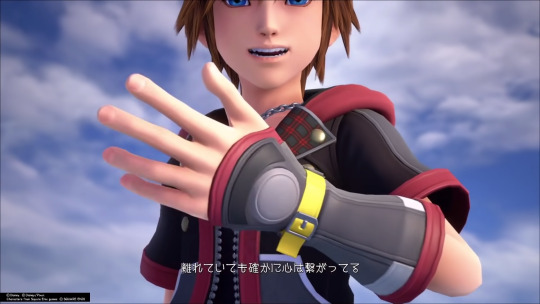
JP 離れていても確かに心は繋がってる
EN It’s true that hearts are connected wherever you are.
TR Even when (they)’re separated, hearts are absolutely connected.
Notes: “Connecting hearts is my power,” is Sora’s motto in Japanese, so it’s not a surprise that he reference heart connections here. And the “even when hearts are separated” language is very, very similar to things Sora has said to Kairi in the past. This scene in KH1 comes to mind:
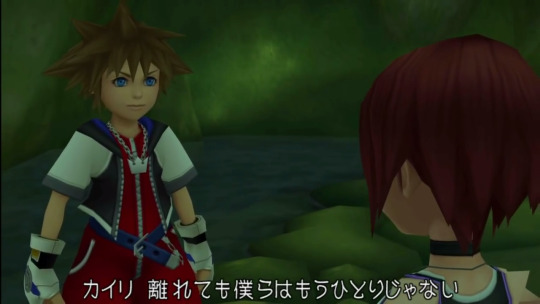
JP カイリ 離れても僕らはもうひとりじゃない
EN Kairi, even if we’re apart, we’re not alone anymore.
TR Kairi, even if we’re separated, we’re not alone.
Before, Sora was okay with being apart from Kairi, because it was enough that their hearts were connected.
Well, that’s changed. Being apart from her isn’t acceptable to him anymore. It’s not enough that their hearts are connected; he actually wants to be by her side. That’s his priority now.
He makes a fist to indicate he truly believes what he’s saying:

Look at his expression of peace and confidence:

We get this shot of Kairi listening intently to his words as he continues. It’s clear she thinks highly of his opinions, and much like he admired her earlier, she admires him here:
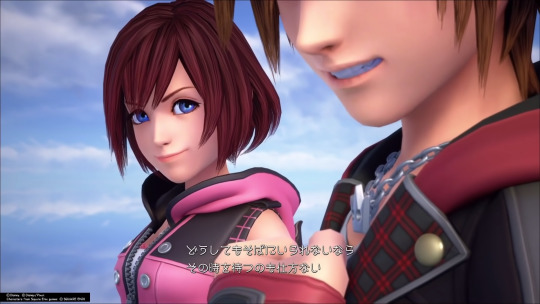
JP どうしてもそばにいられないなら その時を待つのも仕方ない
EN If it’s impossible to be together, then all you can do is wait.
TR If you can’t be together at all, then all you can do is wait (for that time).
Notes: I’m a little shaky on the “for that time” bit, because I think it’s supposed to mean “all you can do is wait for when you can be together again,” but I’m not 100% sure. Anyway, “be together,” sobaniiru, is more literally “be by (each other’s) sides, but “be together” sounds more natural in English.
Sora also uses the common expression shikatanai to indicate sometimes it can’t be helped, all you can do is wait. Shikatanai is a very common phrase that’s useful in a wide variety of situations, so if you’re learning Japanese, that’s a good one to remember.
The next shot is a high angle centered on Chirithy. We saw Kairi’s reaction to Sora’s words, and now we get to watch Chirithy’s:

JP でも もし そばにいられるなら そばにいたほうがいい
EN But, if it is possible for you to be together, then that’s how it should be.
TR But, if you can be together, it’s better to be together.
Notes: Sora uses the ~hōgaii construction to give Chirithy advice here.
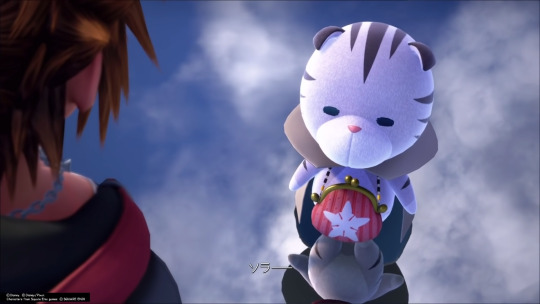
JP ソラー
EN Sora...
TR Soraー
Notes: No differences really, Chirithy just says Sora’s name.
Then we get this full shot of the three of them again to draw our attention to the beauty of the Final World:

JP ここはさ 確かにきれいな場所だけど 一人で見るより大事な人といっしに見たほうがいい
EN You know, this really is a beautiful place. But you’d enjoy it so much more with someone you care about.
TR This place really is beautiful. But it’s better to see it with someone important to you (lit. an important person) than it is to see it alone.
Notes: To avoid having my translation be really choppy, I reordered the words a bit. But in the Japanese version, Sora says something more like “Here (emphasis), is a really pretty place but,” if I were to transcribe it more literally. He also contrasts seeing this place alone (which is nice enough, and which he has done) to seeing it with someone you care about (which he has also done), literally daijinahito in Japanese. The latter is far preferable in his eyes, and he once again gives Chirithy advice using ~hōgaii.
Next, we get this shot of Sora to draw attention to what he does next...

...which is look at Kairi. He says these words, he talks about how important it is to spend time with someone who is precious to you, and it’s clear from his body language who he considers important:

He smiles as Kairi turns her head to look at him:
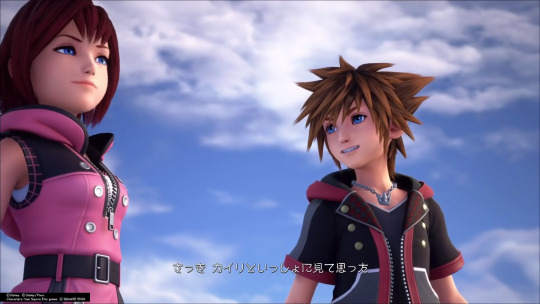
JP さっき カイリといっしょに見て思った
EN Before, when I was looking around with Kairi,
TR Earlier, when I was looking around with Kairi, I thought
Notes: We get a better idea of what was going through Sora’s head earlier as he gazed lovingly at Kairi and only briefly looked at the scenery.
Kairi looks at him...
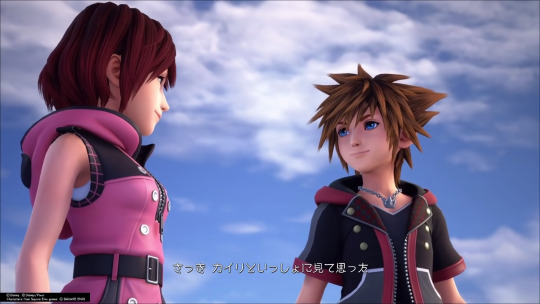
...they share a moment...
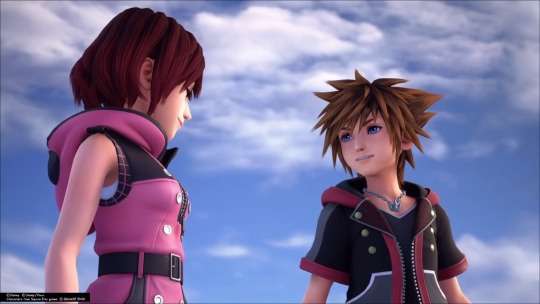
...and then Sora explains to Chirithy what he thought about:

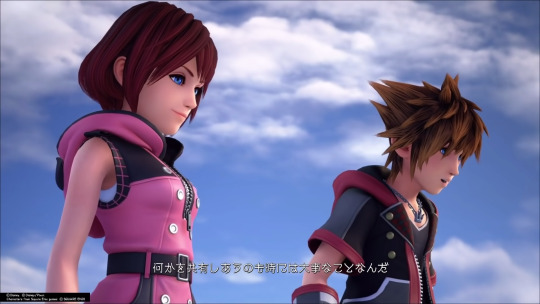
JP 何かを共有しあうのも時には大事なことなんだ
EN I remembered how important it is... to share moments with friends.
TR Sometimes it’s important to share some things (with someone else/with each other).
Notes: When Sora looked at Kairi earlier, he realized how important it is (again, the word daiji is used here, paralleling the use of daiji earlier) to share things with her. He is, by extension, generalizing that advice to Chirithy to get Chirithy to agree to go home to Ven.
And because it has to be said... (insert deep sigh here...) there is no mention of “friends” in the Japanese version. The English version probably added it in because the sentence would’ve sounded too vague and unnatural in English, which you can see by my more literal “sometimes it’s important to share some things (with each other).” Do you know anyone who talks that vaguely? Exactly.
This is not “proof” Sora friendzoned Kairi in the English version either. He is taking an empathetic stance and is relating his situation with Kairi to Chirithy’s situation with Ven. Obviously, Sora’s bond with Kairi is different from Chirithy’s with Ven, but what they share in common is that they consider the other person important. And of course Sora would consider Kairi his friend; that’s the foundation of any good romantic relationship. Just because he calls her his friend in the English version does not mean that’s all he sees her as (clearly, as he keeps looking at her lovingly throughout this whole scene). Besides, either the English version of the games gets priority in terms of interpretation, or the Japanese version does (or you take a third option and use both to interpret scenes). Consistency is key here, and all I ask is that other people translating and interpreting these scenes give a fair shake to both versions instead of cherry picking which one suits their narrative better.
Anyway, continuing on.
Sora finishes his speech, and the focus is once again on Chirithy:

JP だから いっしょにここを出て チリシィの友達のところに連れて行くよ
EN That’s why you’re coming with us. I’m taking you to see your friend, Chirithy.
TR That’s why (you)’re leaving this place with us. We’ll take you to your (lit. Chirithy’s) friend.
Notes: “Friend” pops up here in the English version, but only in reference to Chirithy’s friend, aka Ven. The Japanese version uses “Chirithy’s friend” because again, names are more commonly used than pronouns, whereas in English, the opposite is true. Also, Sora ends his statement with the particle yo to give it a little more emphasis.
Chirithy is so touched that it starts crying over Sora’s kind offer:
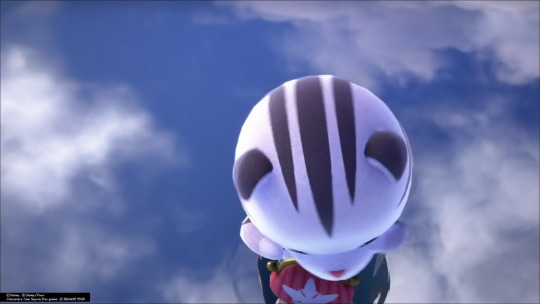
And then Chirithy agrees and bows:

JP うん
EN (Sobbing noises)
TR Okay
Kairi likewise nods to show her agreement:
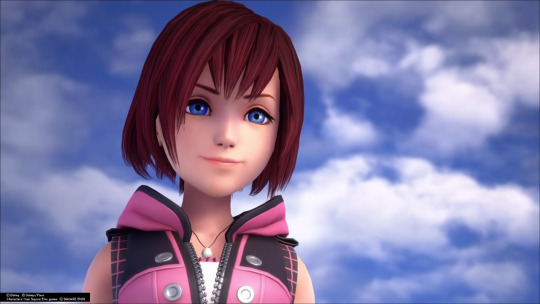
And then we get this shot of Sora and Kairi from Chirithy’s POV:
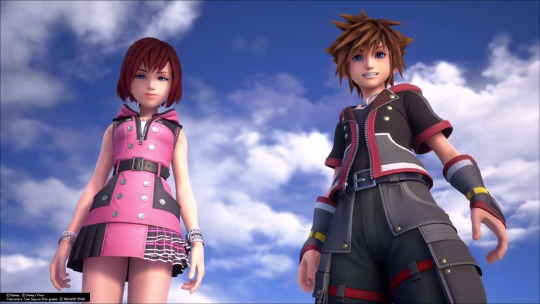
They smile at Chirithy, and Sora offers his hand, just like he did to Aqua earlier in the game. Notice how they both bend down a little to once again bring themselves closer to Chirithy’s level:
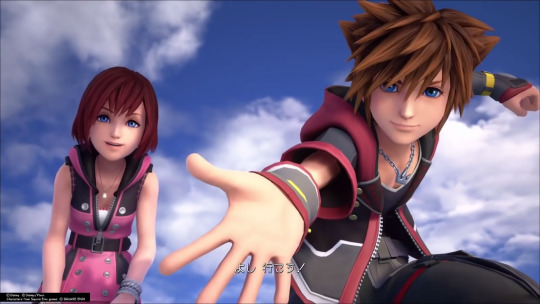
JP よし 行こう!
EN Okay! Let’s go!
TR Okay, let’s go!
Notes: Pretty straightforward meaning, no additional comments here.
And that’s a wrap! The scene fades to white:

Thank you for taking the time to read! Screenshots are from here. General disclaimer about how my Japanese abilities are a work in progress, same with my translation abilities, and I’m working on learning how to do more film analysis type things. The guides here and here were excellent references for different types of camera angles and shots.
#sokai#re:mind#re:mind spoilers#kh3#kh3 spoilers#kingdom hearts#kingdom hearts 3#kingdom hearts 3 spoilers#kh translation#kh analysis#phoenix plays kh3#sora#kairi#chirithy#phoenix downer#phoenix translates#long post
206 notes
·
View notes
Text
Something New

©NESPRESSO

©DUALIT
“Learn something new. Try something different. Convince yourself that you have no limits” Brian Tracey
Research the Narrative
Point of sale product shots demand a high degree of photographic finish and quality. They should represent a product at its highest quality.
Within your blog/workbook, research product shots and advertising photographers. Demonstrate through annotation, your understanding of detail and presentation of perfection.
Tell the Story
Choose an item that is brand new and blemish free and photograph it to the highest quality possible.
Your object should be photographed with a plain white background to show maximum quality.
Care should be taken to ensure that the best lens and viewpoint are used to maximize the product shape.
Edit and refine: Complete worksheet
High level retouching will be necessary as the object must be as close to perfect as possible. (even brand-new items will have flaws that need fixed)
Be prepared to use a range of retouching techniques to optimise this final file for use as an advertising shot.
The object should be easily dropped into other background so we will look at ways to cut out and present the object as a vector cut-out.
Submit: Final image on A3 canvas, and the object cut out of the background as a PSD. Upload to my city: Upload to my city.
Research
TOP 5: PRODUCT STILL LIFE PHOTOGRAPHERS
January 19, 2016 admin Brands
This week, counting down on our TOP 5, I am going to be listing my favourite product still life photographers, these are purely based on their portfolio and on their popularity.
STILL LIFE PRODUCT PHOTOGRAPHERS
1. Nori Inoguchi
http://www.norimichi.com/
Born in Japan, NORI Inoguchi was educated in New York where he refined his passion for photography. His love of luxury and desire to create visually stunning images inspired him to become a still-life product photographer; NORI seeks to find beauty in all of the objects he shoots.
With his sophisticated eye and minimalistic approach, he has exploded onto the world stage and has earned bookings from the best names in fashion, cosmetics and electronics. His career has brought him to Paris, London, NY and even back to his native home of Japan.
Using clean, clear and crisp techniques, NORI has created numerous campaigns since 2009 and he has since become a trusted name in the field.
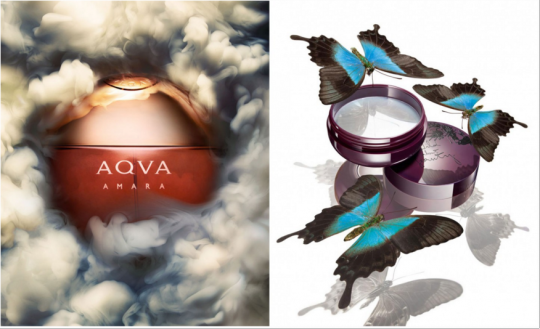


2. Sam Kaplan
http://www.samkaplan.com/
Since striking out on his own in 2011, the 29-year-old Boston native has eschewed high-concept aesthetics and taken a more hands-on approach built around exacting precision—a sculptor’s finely honed interest in process and material. His approach might seem throwback, but that’s part of Kaplan’s appeal. Unlike many of his photographic peers, he had a rather low-tech schooling, studying fine art and art history at Wesleyan University.




3. Lucas Zarebinski
http://www.lucaszarebinski.com/
Lucas grew up in Bielsko Biala, Poland, a small city famous for goose down comforters. When he was 17, he dated an photographer named Olga who later inspired Lucas to become an artist even though he said ” I always wanted to be an artist but I was horrible at drawing.” In the few months he was around her, he realised that he had a talent for still life photography. He then moved to Michigan when he was 20, got a degree in Fine Arts and Photography while he parked cars at night and learned English from his 3 roommates. Fast forward 10 years later. He now live in New York permanently and creates images for a living.
He says in his biography ” I love creating conceptual images, pushing the boundaries of still life photography and resolving client’s problems with an inspiring imagery. I still like red beet soup and blueberry pierogis, but I also like beef with broccoli and spicy tuna rolls these days. ”




4. Jonathan Knowles
http://jknowles.co.uk/
Jonathan Knowles is one of the leading photographers of his generation. Specialising in graphic still life, liquid and beauty, Jonathan’s unique photographic style has earned him award-winning advertising commissions worldwide.
In the past ten years, Jonathan has consistently featured in the ‘200 Best Advertising Photographers in the World’ books. He is one of the top 10 all time award winners in the Graphis Annuals.
Notable commissions include campaigns for many globally recognised brands, such as Coca-Cola, Guinness, and Smirnoff. He is also the creator of the famous O2 bubbles.
He shot the Black Sabbath 13 Album cover, as well as directing and filming the footage that is currently played on stage during performances. Black Sabbath loved the imagery and invited Jonathan to the album launch in New York, where he received a friendly strangle of gratitude from Ozzy.




5. Zachary Goulko
http://www.goulko.com/
Like a modern Chiaroscuro master, beauty, product and still life photographer Zachary Goulko harnesses the power of light to infuse two-dimensional images with drama, shape, and volume. His moody, provocative photographs illuminate the power of a single moment: the arresting beauty of a face, the grace of a sculptural curve, the fluid interplay between light and color and form. It is the Moscow-born photographer’s mission to capture the essence of each subject, and to present its beauty to the world in fresh and unexpected ways. He is an exhaustive experimenter, conjuring moods, intertwining lines with rhythm, exploring the architecture of shape and light. His still life and product photographs are clean and precise, yet startlingly intimate. They achieve a level of visual poetry that is unique in the commercial photography world. With a fully equipped high end studio, based in the New York City area, he photographs product and still life images for many world renown beauty and cosmetics brands. Among Goulko’s clients are L’Oréal, Lancôme, Clinique, Estée Lauder, Strivectin, Shu Uemura, Frederic Fekkai, Patek Phillipe, de GRISOGONO, Roger Dubuis, and Zac Posen, . With a background in design and interactive programming, he is constantly seeking new ways to push the technological boundaries of his medium and give full expression to his creative vision.

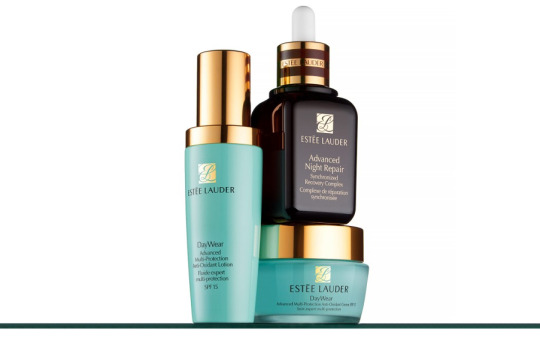


Source: http://claphamstudiohire.com/top-5-product-still-life-photographers/
PRODUCT PHOTOGRAPHY IDEAS
Unusual and even extraordinary product photography ideas are what make many leading brands stay demanding and make people talk about their creative product shots and buy their products. Let me tell you how to do product photography like creative product photographers do. I’ve gathered 20 original product photography techniques and ideas for any product.
What Is Product Photography?
Product photos belong to a branch of commercial photography which is about advertising a product. There are several classical ways of shooting products: product photography on a white background, ghost mannequin, lifestyle product photography, motion images, photos of the product line, tabletop photography, photos of the product being packed, 360 product photography, etc.
Creative Product Photography Ideas
High-quality product photography is important for you and your client. Therefore, it is obligatory to choose the right strategy to demonstrate each product. But many photographers have a moment when they need to diversify the photos or add some creative elements. Here are some different product photography ideas for your inspiration:
1. One Second Before

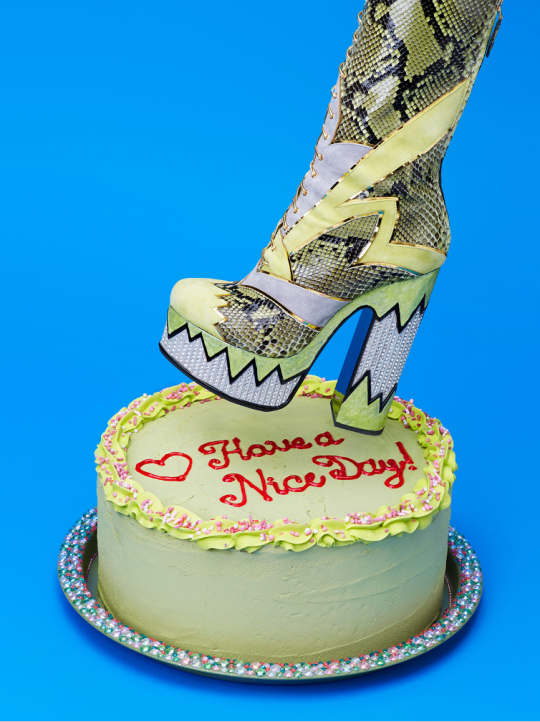
This is an example of creative product shots that are taken right before something unexpected: an explosion, fall, etc. That is why you as a photographer should manage to catch the moment in the second before it happens.
2. Use Smoke


This product photography idea is a good way to make your product look dramatic. Use the coloured smoke if it is suitable for your product design. To make smoke more accurate, use Photoshop brushes.
3. Floating Products

You may hang some goods to make them look three-dimensional. Hang a product using a line, wire or rope. Then remove background or a line from the photograph of a floating product in Photoshop.
4. Association Game
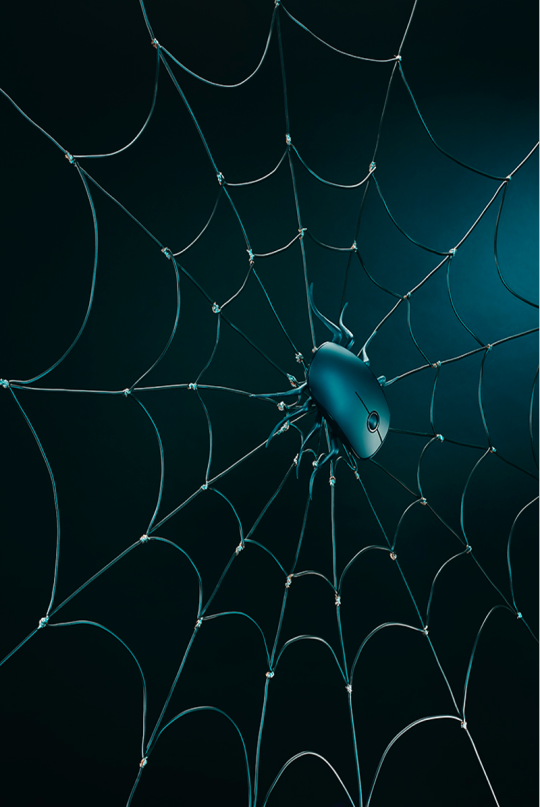
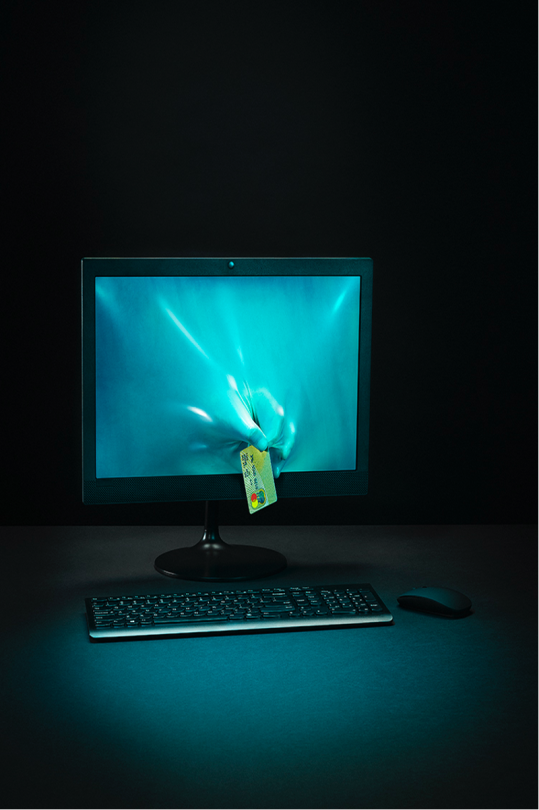
If you need extraordinary product photo for a fashion magazine or billboard advertising, what can be better than funny surrealistic illustrations. Such photographs are typically taken in the studio using special product photography lighting kit and digital drawing techniques in Photoshop.
5. Motion Product Photography


This creative product photography idea is realized by means of short exposure and quick photographer’s and assistants’ actions. The photos are striking for a lot of reasons, but the thing that sticks out at first is how adding motion makes images pop.
6. Photo with Models

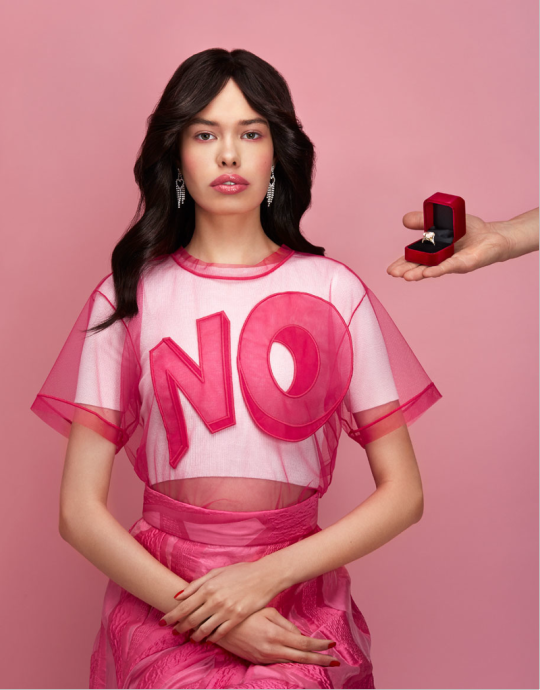
Give your product character and show the features that make it unique. Use different product photography ideas and creative lifestyle to highlight the product usage.
7. Combined Background


In addition to the familiar white background, I frequently use the background tone that is in harmony with the color of my product. These two product photographs are a good example of colors combination. You may combine the background depending on the product color increasing the image contrast.
8. Crashed or Broken Product

It is pretty a specific idea for product photos and not everyone decides to use it. It attracts people’s attention and evokes pity and interest to the product. It is better to get a shot at the beginning of product crash.
9. Use Reflection
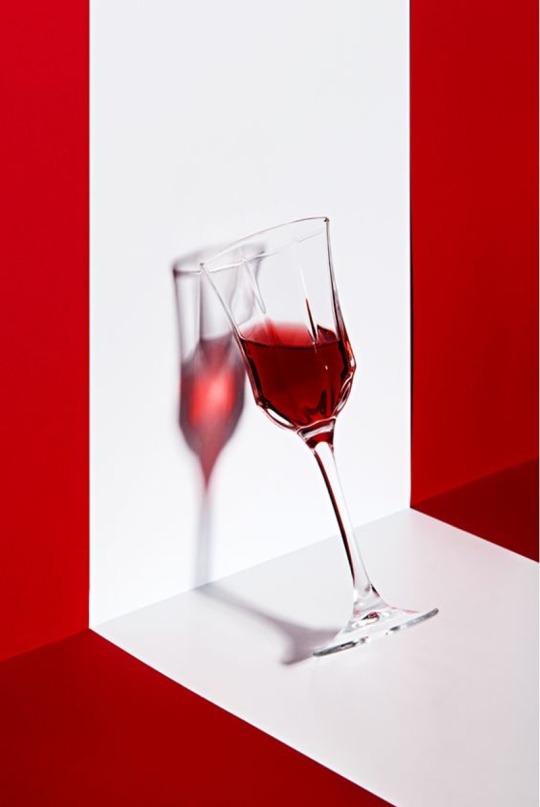
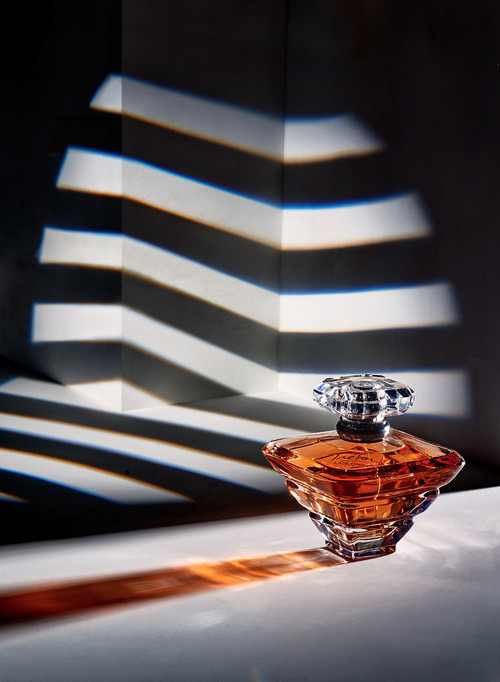
You may use smooth plain covers with high reflectivity as the surface. For example, your product photos may be taken on an average ceramic tile. Make sure, you work in good lighting. In order to take such image, it is necessary to choose the right angle and lighting to get excellent reflection.
10. Product Absorption
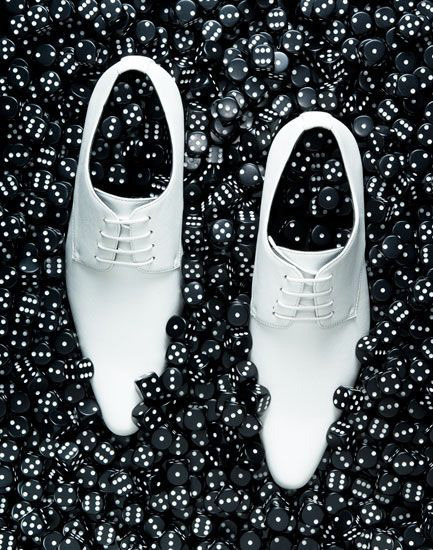

This product photography idea has something to do with putting an object into the sand, water or other materials when you intend to put an accent. You may also use different tiny thematic items in which the product may drown.
11. Product Series
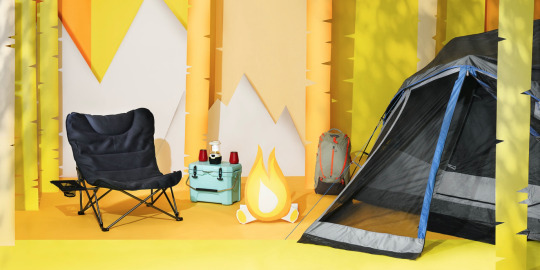
Grouping product images creates almost the same effect as zooming. Comparing several products in one photo a customer understands their main differences, volume, shape, size and other features. Moreover, it can persuade your potential customers to buy the whole kit.
12. Symmetry and Dynamics

To take this kind of product photos you have to put a camera at different angles. However, you should be careful while shooting obscure angles in order not to misrepresent the product. Put other products relatively symmetrical mixing them up with different small details.
13. Emphasize the Product’s Colour
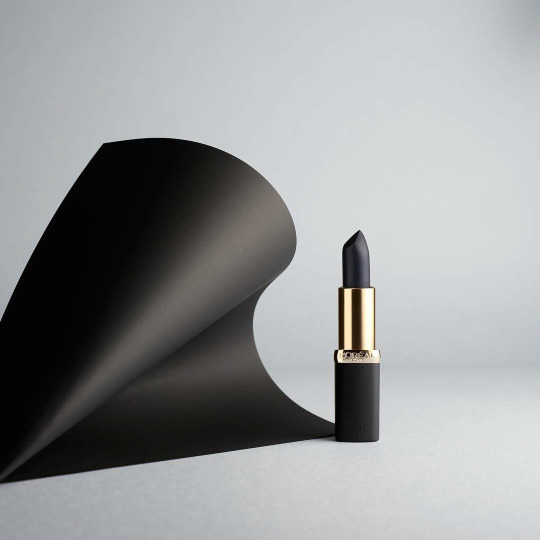
Showing the contrast between the background and the product looks fashionable. But the main difference of this photo is an angle between the surface and the background, which creates a three-dimensional image of the lipstick. This dimensional curved shimmering paper underlines the color and the dimension of the product.
14. Sand Print
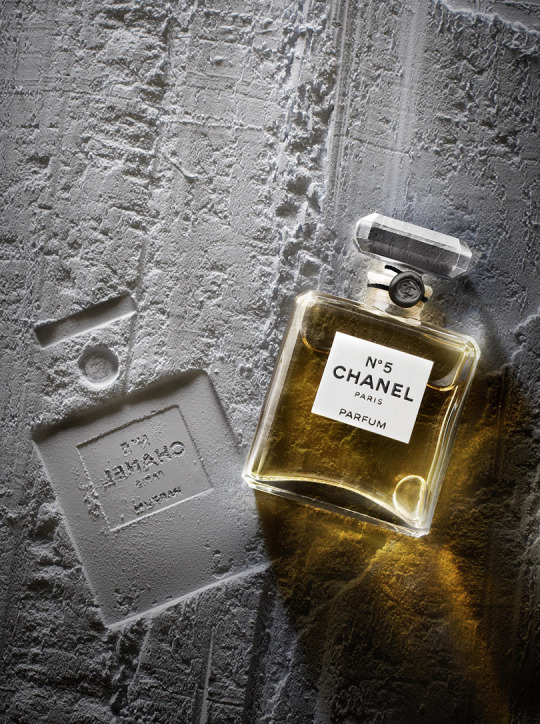
This product photography idea requires a special background. It may be usual clay, snow, sand, mastic or similar material.
15. Use Associations

Be as much creative as you can. Here Photoshop is you best friend who will help to realize even the craziest product photography ideas as to shape ketchup in the form of a tongue or a lipstick in the form of ice-cream.
10 Famous Product Photographers
https://spark.adobe.com/page/98pcx7gV8QkNW/
3 notes
·
View notes
Text
WIP Day #3
Your Canon-Verse WIP.
I give up. There are still two hours left in the day, but that’s not nearly enough time for me to beat this thing into shape. Instead, I’ll give you a peek.
I don’t know if this actually counts as canon, because I made up all of it. My goal was to try and keep the character dynamic more or less canon-compliant, but uhh, I think we don’t get to canon events in this snippet.
Fandom: The Raven Cycle
Characters/Pairings: Kavinsky (+Ronan)
Rating: Mature for child abuse, bullying, homophobia, drug abuse, and being wacky in the head, I suppose
When I started this: October 2016, in one form or another
When I last touched it: March 2017
But first, another of my unnecessary and unnecessarily long comments: This grew out of my first try at TRC fic, which thankfully never made it to the light of day. It was that obligatory canon character study, but it was terrible. I repurposed some lines for a rewrite and tried different approaches, like splitting it up and using the individual parts for other projects, which is probably why the mood is all over the place.
For the purpose of this WIP challenge, I stitched some back together and added some ideas I had regarding K’s potential backstory. Today’s edit also weirdly turned the mood in this from rather sad to slightly dark and fucked up. Go me.
Under the cut, you’ll find nearly 2k of “idk what this is, whether it makes sense, or if I should continue to work on it.” (I pretty much just like stacking words on top of one another and wait for them to topple into place.)
Enjoy. If you can.
You tell yourself you haven't always been this pathetic.
You've spent many hours in grand stupors, passed out on bathroom floors, hallways, stairs even, waking to a pain in your head, your joints, your heart that would only grow worse over time unless you get another fix -- to alleviate the emotional impact if not the physical one -- and sometimes you don't because you're unable to move, unable to do anything but sink deeper into the pit of despair that lurks so far below the surface mere cutting tools don't reach it.
Yeah, you've been there and you've grown used to it, used to starting awake in strangers' cars, in stranger's beds, on strange piles of shards and other things with jagged, rending edges, like yesterday's trash, broken and forgotten.
You've grown used to starting awake to strangers in your house, on your floor, your bed, (you -- like your body's a blow-up doll and no longer yours when your consciousness vacates it for a while,) used to loud music, fast cars, and neon strobe lights, used to having crowds around you, fawning over you, spewing the same sycophantic bullshit as anyone else, while their drinks slosh dangerously in their cups and their fingers find their way into your hair, your mouth, your pockets, turned inside out in search for what only you can give them: the ride of their lives.
Disorientation became your game and you played it till you won.
It was a way of life and you were living it, disregarding that you were already dead inside.
You've been in a string of pathetic situations before you learned to ride the buzz and not let it ride you, before you learned that staying high and staying in control were not mutually exclusive even if it was fun for a time to give up one for the other. Keeps you on your toes.
Going up, you never worried about coming down. You never worried about anything.
So, you've been fucked up a lot, but you've never felt as fucked up as you do now, empty and shaking and so alone. There are texts on your phone, but your thumbs too numb to open them, the screen is screeching at your eyes, and the messages are garbled as if the words had been thrown into a blender. They don't go through to you.
Inside your chest, a nauseating merry-go-round made of razor wire is slicing at you, whittling you away, carving you hollow.
You like to think you haven't always been this way. That there's a progression to these things.
Yours seems inevitable enough.
You still remember the days before now, before this, before everything, although you try your best to erase them, line by fucking line. It's easier to forget than to go running around with all that baggage. Who needs that shit anyway?
You were a sweet-faced boy, the aunts told you, by which they meant you look like a girl. You hated that.
They weren't your aunts, but wives of the men who worked for your father, and they came by to keep your mother company when he was away. Or busy. Or both. Which was all the time. You thought of them as a flock of birds for their matching outfits, their gleaming jewelry, their impeccable hair, the way they tittered and they cooed, and how you've never seen one arrive without the others.
So they perched on the sofa and the armchairs, coffee cups daintily placed on their saucers, and they sang their merry tune of how lucky your mother was for having such a sweet boy, such an angel, he does so take after you, dear. They simpered, pinched your cheeks, ruffled your hair, and you hated it at the time, hated that you had to be still and smile and endure it, because if you did, they'd stop fussing sooner instead of later, growing bored with you as if you sort of faded in the background.
But you liked the attention all the same. At least somebody noticed you for a while.
*
The aunts brought their sons, if they had them, and brought toys if they didn't. Action figures, toy cars, dinosaurs, whatever they'd been told young boys your age were crazy about. Or they brought stories about how they would also like a son, a healthy, strong son, because their husbands wanted one, so that is what they should want, too. Maybe they did, but you couldn't tell, you could only overhear bits and pieces when you sneaked into the kitchen to get away from the other boys.
You were supposed to be playing with them, be nice to them, but they weren't nice to you, so why should you care? You were small, you were fine-boned and you were pretty, and nobody liked you.
But it was okay, you didn't like them either.
Except that you did, in ways you didn't understand at the time, because nobody told you about these things and you never had the chance to figure them out for yourself.
Maybe they didn't like the implications of you, maybe you made them feel something they weren't supposed to feel, maybe there's always been something despicable about you. Maybe that was it. All you know is that they teased you, that they made you cry because of it, and that your father didn't want a cry-baby for a son. He never called you his son, he called you other things that took you years to understand, things that the boys in your backyard echoed before they wrestled you to the ground and stuffed sticks and soil and sand into your mouth and made you swallow.
You still remember their names or what names they called you, what they looked like,
what they made you feel.
Your father never said anything to the boys or their fathers. Why would he? It would draw attention to what a pathetic weakling you were and he was probably too ashamed of you already. His preferred method of making sure you wouldn't get beat up again was taking the matter out of their hands. You earned yourself a clout whenever he caught you sniveling, sometimes even if it was from a cold, and sometimes he wouldn't stop until you stopped.
Sometimes you wondered if he wanted you to stop completely.
You were supposed to stand up for yourself, that was the understanding.
Your mother didn't like how he ruined your face, you were her handsome boy after all, but she also did nothing to stop him. That was fine with you. If he used his fists on you, maybe he wouldn't have to use them on her. (That was before she took to hitting you as well, you devil child, you cursed evil thing, when you still had some loyalty in you, some sense of solidarity.) He never hit <em>her </em>face, but a shiner or two on yours were okay because it detracts from your looks and adds character. Simple as that.
It's a lesson you took to heart and made use of at school. Your father liked to see you get into fights, liked it when you came home with scarred knuckles and split skin, when you proved to him you were a man after all and worthy of being called his son.
You stare into the mirror. Nothing stares back. You're seeing through yourself, at the wall in the back, or maybe the back of your head. It's dark in there, it must be, you cannot see the light.
You're covered in gasoline and someone struck a match. Your skin is burning.
This is what his touch must feel like. Around your throat, squeezing the life out of you. Whatever life there is left of you.
You splash some water on your face and it reappears in the mirror.
Pretty thing, they used to call you. They used to beat you up for it, as if your looks were somehow offensive to them.
No one would call you pretty now, with your sunken cheeks, broken nose and bloodshot eyes, and you prefer it that way.
You conceal the damage of last night and the many nights before with white sunglasses and a grin that's as changeable as your mood while it remains one thing at its core. An impenetrable fortress.
Your parents may have taught you something useful, after all.
There must have been a time when you thought your parents loved you, that they just couldn't show it in words or gestures, so they showered you with gifts to distract you from their emptiness that was becoming your emptiness.
"You need to stop spoiling him," they told each other when they thought you couldn't hear, but they never did.
When you woke up to yet another gift on your pillow, one you've been wishing for very hard but never had the chance to tell them about, you thought it was their way of saying sorry for being so distant. You thought it was their way of soothing you after your nightmares.
You were delighted by it when you were very small, and put off by it as you grew older, because you saw it as a cheap ploy to buy your loyalty. Fuck that.
Until you noticed they didn't get you anything.
"You're spoiling him too much. He's soft enough."
"I thought you got him this toy."
The answer to this riddle, however, was a much better gift than anything they could have given you.
You know now that every gift comes with strings attached. And sometimes, those strings are darkness itself.
Come to think of it, your mother never hit you before your very existence started to threaten her sanity. Not that she'd had much of it to begin with, but your dreaming didn't exactly help. It only exacerbated it. And then, when you killed your father and he still continued living after that, well, that was the end of it. She never let you live that one down.
Or she wouldn't, if you kept her sedated any less. She prefers the brain fog to the knowledge of what you are, too. Otherwise she could have left a long time ago. Tried to, in fact, but even with her means, she was unable to find anything that killed her brain that what you provided for free.
Family discount.
You've had enough to drink for a lifetime, but there's a restlessness eating you up from inside that you need to douse and you know just the thing to do it with.
It comes in a plain vodka bottle, looks and tastes like lighter fuel, and the fumes alone are enough to intoxicate you three ways from Sunday.
The best part about it, however, is how much it burns. Every swig of that hellish concoction is another splash of kerosene onto that ever-raging fire that is consuming the very fiber of your being.
You know who you have to thank for stoking it, for making it so unbearable to take another goddamn fucking breath.
Family, you think. It's more of a curse than a thought, really. But it rams itself into your head with the force of a sledgehammer.
Family. Now there's an idea.
#the raven cycle#wipweek2017#wipweek: day 3#joseph kavinsky#rating: mature#backstory#my stuff#crookedspoon writes dumb shit#wips#snippets#lots of words stacked on top of one another#ugh i am never ever going to post a fic of this format to tumblr#trying to figure out where one section ends and the next begins was a pain#do let me know it this is actually something you'd like to see completed in one form or another#still on the fence about what to do with it#might just hack it into pieces again and use it for parts#wipweek
5 notes
·
View notes
Text
Worth The Whistle
When making ovational pronouncements about their homeland, the Irish are rhapsodic leagues ahead of most nationalist spokesmen. Irish parlance feeds upon the fanciful, and when summarizing their realm of origin, many of Ireland’s offspring--writers in particular--are quick to describe a place that might have been both freshly created and steeped in mythologies long past. The reverence for his country described by novelist and broadcaster Frank Delaney ably captures the painterly affection shared by his tribesmen: “When the sun lights a particular hill in the distance...and it is green and silken to my eye, and the clouds have begun their slow, fat rolling journey across the sky, no land in the world can inspire such love in a common man.” [1] In visions of this sort, the extraordinary and the everyday cultivate each other, and even God’s rudest labours can be a source of inspiration. Consider James Joyce, reveling in backhanded salute to the rougher primordial influences upon his stamping grounds: “Isn’t the sea...a great sweet mother? The snotgreen sea. The scrotumtightening sea.” [2]
Included on the long literary list of Ireland’s tribute-paying sons and daughters is David A. Wilson, author, editor, and expert explorer of Irish history. Among his books are Paine and Cobbett: The Transatlantic Connection (1988), United Irishmen, United States: Immigration Radicals in the Early Republic (1998), The History of the Future (2001), and the ambitious biographical doublet, Thomas D’Arcy McGee, Volume 1 (2008) and Volume 2 (2011). A tireless academic, he is also a professor in the University of Toronto’s Department of History and Celtic Studies Program. (Before I continue, the obligatory disclosure is due: though I’ve never met Wilson, there is a familial connection. Also found on his scroll of vocational titles is general editor of The Dictionary of Canadian Biography, a publication whose supervisory editor is my sister, the relentlessly revising Willadean Leo. Though she has throughout her career worked with a wide selection of impressive colleagues, she has also had a number of professional associates whose exploits I wouldn’t bother to acclaim. Wilson, it happily turns out, is not among the latter.)
Wilson allows himself liberal opportunities to praise his native soil and much that it supports in Ireland, a Bicycle, and a Tin Flute (1995), a diverse and diverting account of a solo cycling trip he undertook along the Emerald Island’s summoning coast. He begins his travels and the book that depicts them in Whitehead, a northern seashore town and the setting of his birth. From there he goes on to an engaging assortment of communities, including Islandmagee, a peninsula he cites as “perfect cycling country” thanks to a lack of traffic and a modest steepness to its hills; Corrymeela, an interdenominational locality dedicated to promoting understanding between religious groups; the town of Clifden, known and enjoyed for its annual arts festival, which he finds “crackling with energy”; Dublin, “a cyclist’s nightmare,” where both the streets and pubs are teeming; and Belfast, with its long, inescapable history of political conflict. The book is episodic, anecdotal, and zealously scrutinizing, weaving together impressions of towns and territories, with historical background, political commentary, and mythological colour contributing to the bounty of Wilson’s account. But the journey’s primary pursuit is of music, specifically Ireland’s traditional songs and the many performers who interpret them. His sole companion throughout is a tin whistle, a type of fipple flute, also called a penny whistle. It proves to be excellent rambling company for Wilson, who regards it as the ideal travel instrument (as it’s so easily transported by bicycle) and prizes it for its “brevity and simplicity...a narrow range of notes and a wide range of feeling.”
The book proceeds with an airy bustle as Wilson pedals down rugged roads and up challenging slopes, through blistering rain and lush rural landscapes. Despite the journey’s demands, he’s well-suited to the role of musical detective, maintaining throughout an unflagging spirit of investigation as well as the sputum to gatecrash forbidden territory. In one such circumstance he’s forced to shinny through a high, narrow pub window and drop into the arms of a group of helpful carousers, all for the pleasure of joining a music session after the grumpy proprietor has locked the front door. And, luckily, he has the wiliness needed to dodge potential social jousts as well as outright threats to life and limb--as in an episode in which a group of violent ruffians demand to know if he’s Protestant or Catholic. Wilson casually disentangles himself by replying, “I’m from Canada--we don’t have Protestants or Catholics.” Between social junctures, welcoming or otherwise, his tour yields up a loamy mix of songs, which includes time-honoured Irish, American pop, and the hybrids resulting from the two. (The cowboy standard The Streets of Laredo is derived, it turns out, from a popular ditty about Irish patriot Robert Emmet.) Wilson also delves into the melodious contributions made by Turlough Carolan, a legendary harpist of the late-seventeenth and early-eighteenth centuries, blinded before the age of twenty; Michael Coleman, an influential fiddle player who became a successful recording artist in the United States; and Francis O’Neill, a flutist who emigrated to America, became a superintendent for the Chicago police force, and published a seminal book that endowed posterity with over a thousand folk songs from Ireland.
But it’s in the recountings of the many shows and sessions attended by Wilson that the book is especially shapely and evocative. It’s more than apparent how compelled he is by the mutable nature of music, its fluidity and seductiveness, and the uniting claim it makes upon a crowd, guiding and defining both the musicians creating it and the audience consuming it. The performance of a young accordion player and her band is one of many captivating experiences Wilson reports upon: “She sat on a chair in the middle of the stage, moving from lighthearted waltzes to high-speed reels, deep inside her own world, thoroughly immersed in the music, swaying and smiling with the currents that flow beneath it all. Accordion, fiddle, guitar, and bass were rushing and running together, thundering into a breakneck finish with ‘The Foxhunter’s Reel,’ leaving us shouting and stamping for more.” Despite the exuberant public nature of the many entertainments that he takes in, Wilson is never far from the creative intimacy of such occasions, as well as the recognition that musicianship is its own private caravan, and that music, no matter how penetrable it may be, remains a rich and limitless enigma, something that can never be completely perceived, captured, or explored. It’s during these passages as well as his descriptions of the landscape (also bewitching, overwhelming, and mysterious) that his writing is at its most beckoning, revealing its own quality of music.
Though there’s a current of wonderstruck devotion running from chapter to chapter, Ireland, a Bicycle, and a Tin Flute is overall relaxed and larkish, demonstrating a strong appreciation for mischief and revelry (alcohol is chronically within reach, no matter which town Wilson is visiting), as well as a fondness for the odd, the wayward, and the fantastic. His visit to Whitehead prompts childhood memories of the area’s chilly seafront cliffs and caves and the tale of an outcast madman who took refuge among them and consequently shivered himself to death. And, like a page out of Sheridan Le Fanu, there’s mention made of a true horror story from 1888 in which a northern lake filled up dangerously high during a storm, enough so for its surging waters to gulp down an impatient military man and his driver, coach, and horses after the order was given to “drive on to hell.”
The cumulative effect of this book is of a picaresque adventure following its own abounding soundtrack, with both the journey and its chronicle, to borrow an old phrase, worth the whistle. (A small dissenting note, however: featured on many pages are a series of illustrations by Justin Palmer, and while the sketches have their own energetic virtues, they can’t be called a necessary inclusion. Wilson’s writing is satisfyingly visual as it is, and Palmer’s imagery hasn’t the polish and openness of the narrative it accompanies. That said, the drawings are certainly likable enough and do the book no harm.)
Edna O’Brien, a mercurial talent and an enticing literary companion, has stated that the gift of language has been her bread and wine. The same, I think, should be said of Wilson, who enjoys putting a certain tang in the tale. But music too must be included and highlighted on his aesthetic bill of fare. He knows its pleasures and contradictions too fondly and too well to be a mere sampler at the gathering.
Notes
[1] Ireland, Frank Delaney, Harper Collins, 2005, p518
[2] Ulysses, James Joyce, Oxford University Press, 2011, p5
(Posted: 29/3/18)
0 notes
Text
The old town of Hoi An feels like a museum of well preserved buildings; a unique blend of architectural style drawing on influences from China and Japan, with just the right dash of Europe. The wooden houses are painted in bright colors and decorated with hand-made lanterns in a myriad of colors, shapes and sizes. Old-style communist speakers hoisted along the main road play soft french music during late afternoons, transporting you to a bygone era. Open store fronts are flanked with smiling faces of local girls dressed in elegant Ao Dai made of flowing silk fabric in soft pastel colors…
Hoi An is the best shopping destination for custom clothing and shoes, gorgeous ceramic pottery, embroidered linens and bags, and beautiful artwork! More on this later…but first we must start on our self guided tour of the old town :)
The ancient town of Hoi An is one of the finest examples of a well preserved South East Asian trading port dating from the 15th – 19th century. This is largely due to its status of a UNESCO world heritage site since 1999, and a required entrance ticket costing ~120,000 VND for a foreign visitor (roughly USD 6). The ticket comes with 5 coupons that can be used to view any of the sites such as museums, old houses, temples, Japanese bridge, and night market. While the ticket is really valid for 24 hours, the guard told us that we could use it over a couple of days in case we were not able to see it all in one day…

While there are so many sights to pick from, we chose the top locations from the following list: (choose at least one from each for this tour)
Structures: Japanese Covered Bridge
Assembly halls: Quang Trieu; Trieu Chau; Phuc Kien
Old houses: Tan Ky; Duc An; Quan Thang; Phung Hung
Communal houses: Cam Pho; Minh Huong; Quan Cong Temple
Museums: Museum of Trade Ceramics; Museum of Sa Huynh Culture; Museum of Folk Culture; Museum of Hoi An
Traditional arts: Handicraft workshop
Let’s start walking, shall we? :)
1. Japanese Covered Bridge
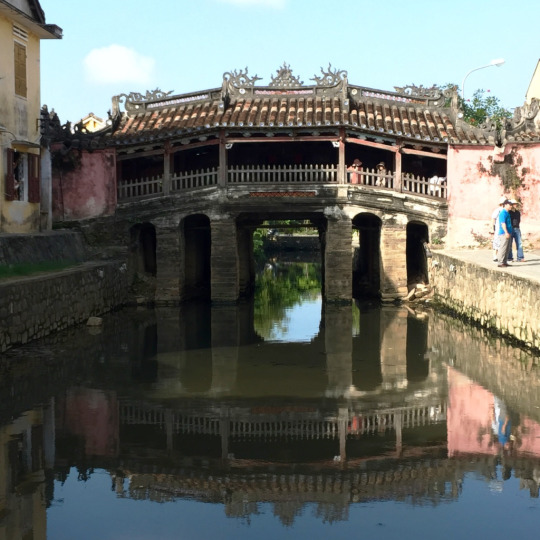
The image of this Japanese Bridge has become the iconic symbol of Hoi An over time; stop here for an obligatory photo! The bridge is free to cross, so don’t get this stamped unless you plan to visit the shrine located on the bridge.
This will seem like a small bridge in comparison to other cities but is a pretty sight for its architectural details, and a perfect reflection in the river. It was built by the Japanese community in early 1600s, and also holds a shrine to the Taoist deity of storms and weather.

Hoi An is best experienced by foot; walking along wide and clean roads, you are likely stop quite frequently to take pictures of colorful house fronts like this one…
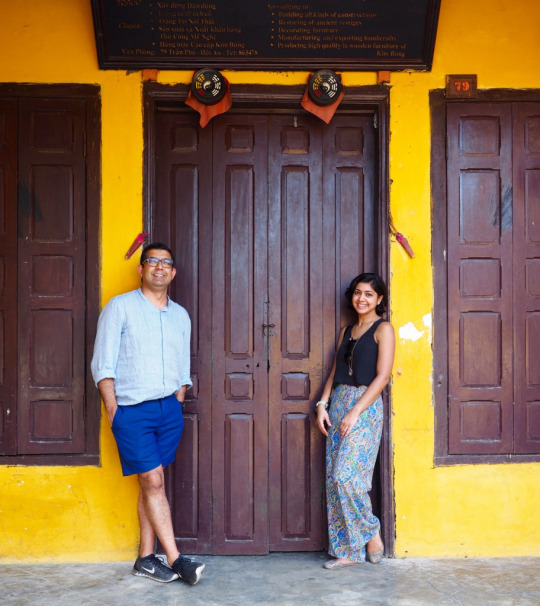
And another with cascading bright pink bougainvillea flowers…

2. Hoi An Central Market (Food Market)
Located on the banks of the Thu Bon River, the Central Market of Hoi An is certainly worth a look to get a slice of Vietnamese life. And you know, we have to stop by a local food market to find out the true flavors of the cusine!

The market is busy throughout the day with locals buying fresh food and wares in the morning. The negotiating over fish usually starts early as the fishermen drop their catch and the market vendors and local buyers dive in to get the best fish.
The market can get very messy, and don’t be surprised by the sight! (fresh chicken below)

Inside the market there is plenty of live ducks and chickens tied together and ready for sale along rows of Vietnamese cooking ingredients.


Next, walk over to the more pleasant side (east) to see the flowers, fruits and souvenirs.


3. Phuc Kien – Assembly Hall
Merchants generally built some fine assembly houses in this region; they needed a place to get together and do business, and of course a shrine for good luck in travel and making money!
Phuc Kien hall was built by the Chinese (Fujian) in late 1600s, and is dedicated to Thien Hau – the goddess of the sea and protector of sailors.

Most of the Assembly Halls in the area are similar in terms of overall architecture, with an ornate entrance, central courtyard, colorful reliefs, and a temple or shrine at the back. The differences are in the finer details depending on who built (or restored) the building in terms of the colorful bas reliefs and shrines.
And each one of these halls is decorated with hundreds of tiny candles and spirals of incense that hang from the ceiling, creating a memorable sight and heavenly smell :)

The spirals of incense with prayers written for good luck?
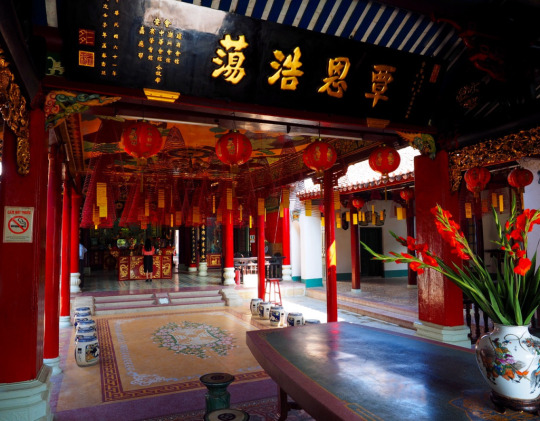
The hall at Phuc Kien was definitely a feast for the senses; incredible colors, sweet smell of incense and light music in the background. If you only have time for one assembly hall, let it be this one!
4. Duc An – Old House
The old houses in the historical town were built by wealthy merchants several hundred years ago, and most of these doubled as shopfronts. Several of the merchants’ families still live in them and you get a ticket to take a tour of the old house (and, of course buy some of their wares while you’re there). However, the houses are really very interesting in terms of the architecture and use of space – take at least one tour!
We stopped by Duc An that once served as a traditional chinese medicine shop and also a bookstore. By the end of the early 20th century, at the time of the anti-French revolts, it also became a popular meeting place for patriotic intellectuals – can you imagine all the conversations and secret meetings that took place here?
Today, the house has wonderful pieces of old medicine cabinets and carved wooden furniture on the ground floor.

Another intersting feature in the old houses were the water markings of prior floods. The old town of Hoi An is prone to annual floods, as the town sits on low grounds and is surrounded by waterways, between mountain ranges. The water is known to rise upto two meters high in the town and ultimately the houses – so the residents would move all the furniture to the higher floors to protect during the flooding season. This regular feature led the houses having developed strategic pulley systems up the floor to quickly move the big items!
5. Quan Cong Temple – Communal House
The communal houses or temples were mostly built in the mid-17th century by both the Vietnamese and Chinese people living in Hoi An.
Quan Cong was an outstanding Chinese general at the time and was renowned for his loyalty and sacrifice to the country. This temple was then built as a symbol integrity and justice.
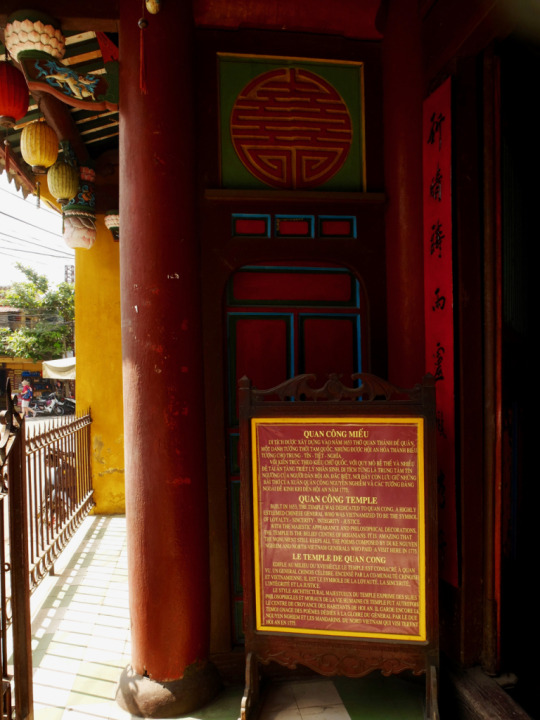
The temple had a pretty miniature bonsai garden with figurines and lotus flowers.

The place seemed so serene and beautiful, I made a small donation and got a good luck charm; and a picture with the temple keeper who had shown us around :)
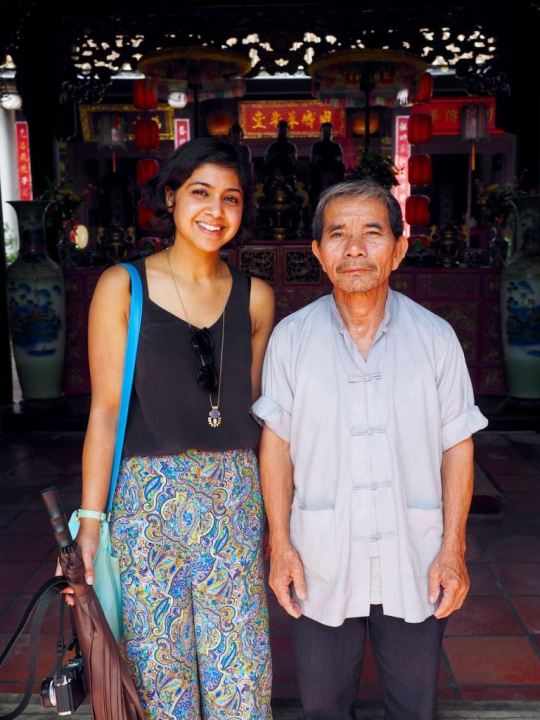
6. Museum of Trade Ceramics
Definitely stop by this museum on your walking tour, the house was even prettier than the relics inside!

The beautiful building is constructed in the traditional Vietnamese architectural style; and is a two storey building with a courtyard and an anteroom.
Since the town of Hoi An was a big trade hub, the main items that were exported were pottery and, traded pottery from different nations, including China, Thailand and Japan.
The counrtyard has a lovely ceramic fountain of bright colors.

Walk up the narrow stairs to the top floor

And you will enter a room with cute windows, pretty lanterns and a balcony with a street view :) a great picture spot!
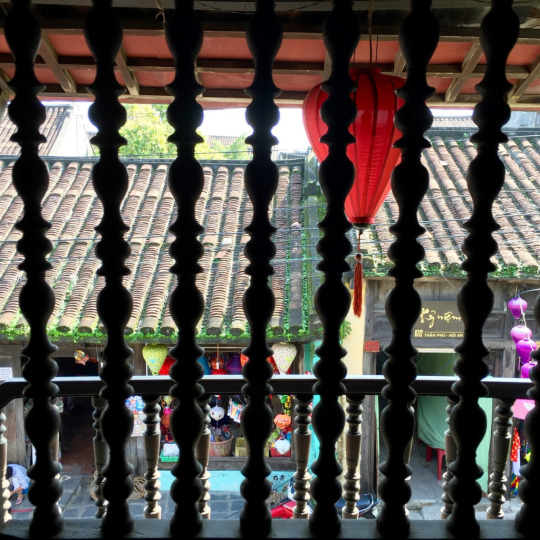
7. Traditional Arts – a little bit of shopping!
And finally, a bit of shopping!
The Handicraft Workshop a must visit, and trust us! you will want to buy everything!
The workshop is set in a 200-year-old building with an interior that is mostly a souvenir shop.
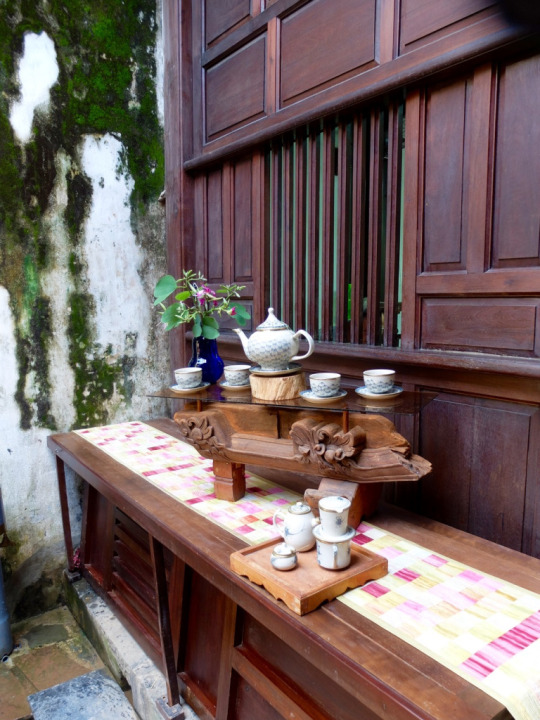
Walk in and you’re likely to see actual artisans at work.

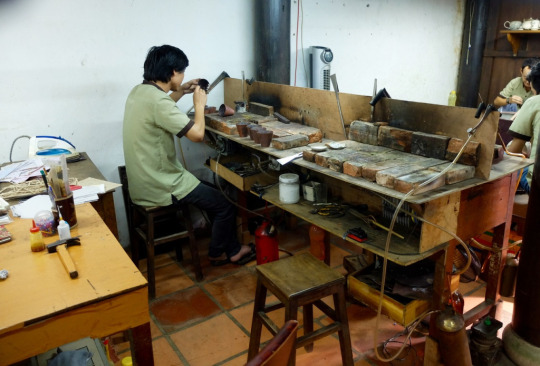
The quality of the goods is quite high and the pieces here are worth the price that you won’t find elsewhere in town. There’s intricate work in metal, porcelain and soapstone, as well as larger terracotta pots and sculptures, quilts and embroidery on silk!
8. Don’t forget to eat!
End the tour with the best and most perfect Banh mi!!!!! yummmmm

Now, off to the hotel to rest our aching feet…(foot massage!)
Hope you enjoyed the tour!! xo
~A&A <3
A walk through colorful Hoi An The old town of Hoi An feels like a museum of well preserved buildings; a unique blend of architectural style drawing on influences from China and Japan, with just the right dash of Europe.
0 notes